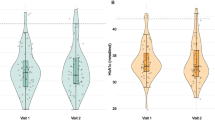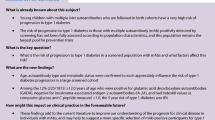Abstract
Aims
Non-diabetic children with multiple islet autoantibodies were recruited to a secondary prevention trial. The objective was to determine the predictive value of baseline (1) HbA1c and metabolic variables derived from intravenous (IvGTT) and oral glucose tolerance tests (OGTT), (2) insulin resistance and (3) number, type and levels of islet autoantibodies, for progression to type 1 diabetes.
Methods
Children [n = 50, median 5.1 (4–17.9) years] with autoantibodies to glutamate decarboxylase (GAD65A) and at least one of insulinoma-associated protein 2 (IA-2A), insulin or ZnT8 transporter (ZnT8RA, ZnT8WA, ZnT8QA) were screened with IvGTT and OGTT and followed for a minimum of 2 years.
Results
Baseline first phase insulin response (sum of serum-insulin at 1 and 3 min during IvGTT; FPIR) ≤3 μU/mL [HR 4.42 (CI 1.40–14.0) p = 0.011] and maximal plasma glucose ≥11.1 mmol/L measured at 30, 60 and/or 90 min during OGTT [HR 6.13 (CI 1.79–21.0) p = 0.0039] were predictors for progression to diabetes. The combination of FPIR from IvGTT and maximal plasma glucose during OGTT predicted diabetes in 10/12 children [HR 9.17 (CI 2.0–42.0) p = 0.0043]. High-level IA-2A, but not number of autoantibodies, correlated to dysglycemia during OGTT (p = 0.008) and to progression to type 1 diabetes [HR 4.98 (CI 1.09–22.0) p = 0.039].
Conclusions
Baseline FPIR, maximal plasma glucose ≥11.1 at 30, 60 or 90 min during OGTT and high-level IA-2A need to be taken into account when randomizing islet autoantibody positive non-diabetic children to secondary prevention.


Similar content being viewed by others
References
Ziegler AG, Rewers M, Simell O, Simell T, Lempainen J, Steck A, Winkler C, Ilonen J, Veijola R, Knip M, Bonifacio E, Eisenbarth GS (2013) Seroconversion to multiple islet autoantibodies and risk of progression to diabetes in children. JAMA 309(23):2473–2479. doi:10.1001/jama.2013.6285
Parikka V, Näntö-Salonen K, Saarinen M, Simell T, Ilonen J, Hyöty H, Veijola R, Knip M, Simell O (2012) Early seroconversion and rapidly increasing autoantibody concentrations predict prepubertal manifestation of type 1 diabetes in children at genetic risk. Diabetologia 55(7):1926–1936. doi:10.1007/s00125-012-2523-3
Salminen K, Sadeharju K, Lonnrot M, Vahasalo P, Kupila A, Korhonen S, Ilonen J, Simell O, Knip M, Hyoty H (2003) Enterovirus infections are associated with the induction of beta-cell autoimmunity in a prospective birth cohort study. J Med Virol 69(1):91–98. doi:10.1002/jmv.10260
Lonnrot M, Korpela K, Knip M, Ilonen J, Simell O, Korhonen S, Savola K, Muona P, Simell T, Koskela P, Hyoty H (2000) Enterovirus infection as a risk factor for beta-cell autoimmunity in a prospectively observed birth cohort: the Finnish Diabetes Prediction and Prevention Study. Diabetes 49(8):1314–1318
Kondrashova A, Hyoty H (2014) Role of viruses and other microbes in the pathogenesis of type 1 diabetes. Int Rev Immunol 33(4):284–295. doi:10.3109/08830185.2014.889130
Chmiel R, Beyerlein A, Knopff A, Hummel S, Ziegler AG, Winkler C (2014) Early infant feeding and risk of developing islet autoimmunity and type 1 diabetes. Acta Diabetol. doi:10.1007/s00592-014-0628-5
Eringsmark Regnell S, Lernmark A (2013) The environment and the origins of islet autoimmunity and Type 1 diabetes. Diabet Med 30(2):155–160. doi:10.1111/dme.12099
Beyerlein A, Thiering E, Pflueger M, Bidlingmaier M, Stock J, Knopff A, Winkler C, Heinrich J, Ziegler AG (2014) Early infant growth is associated with the risk of islet autoimmunity in genetically susceptible children. Pediatr Diabetes 15(7):534–542. doi:10.1111/pedi.12118
Cubas-Duenas I, Cabrera-Rode E, Sarmiento L, Molina G, Fonseca M, Arranz C, Dominguez E, Gonzalez P, Vera M, Diaz-Horta O (2013) First-degree relatives of persons with type 1 diabetes: insulin resistance and enterovirus infection are associated with different patterns of islet cell autoimmunity. Acta Diabetol 50(2):233–239. doi:10.1007/s00592-011-0297-6
Hummel M, Bonifacio E, Schmid S, Walter M, Knopff A, Ziegler AG (2004) Brief communication: early appearance of islet autoantibodies predicts childhood type 1 diabetes in offspring of diabetic parents. Ann Intern Med 140(11):882–886
Orban T, Sosenko JM, Cuthbertson D, Krischer JP, Skyler JS, Jackson R, Yu L, Palmer JP, Schatz D, Eisenbarth G, Diabetes Prevention Trial-Type 1 Study G (2009) Pancreatic islet autoantibodies as predictors of type 1 diabetes in the Diabetes Prevention Trial-Type 1. Diabetes Care 32(12):2269–2274. doi:10.2337/dc09-0934
Stene LC, Barriga K, Hoffman M, Kean J, Klingensmith G, Norris JM, Erlich HA, Eisenbarth GS, Rewers M (2006) Normal but increasing hemoglobin A1c levels predict progression from islet autoimmunity to overt type 1 diabetes: Diabetes Autoimmunity Study in the Young (DAISY). Pediatric diabetes 7(5):247–253. doi:10.1111/j.1399-5448.2006.00198.x
Sosenko JM, Palmer JP, Rafkin-Mervis L, Krischer JP, Cuthbertson D, Mahon J, Greenbaum CJ, Cowie CC, Skyler JS, Diabetes Prevention Trial-Type 1 Study G (2009) Incident dysglycemia and progression to type 1 diabetes among participants in the Diabetes Prevention Trial-Type 1. Diabetes Care 32(9):1603–1607. doi:10.2337/dc08-2140
Sosenko JM, Palmer JP, Greenbaum CJ, Mahon J, Cowie C, Krischer JP, Chase HP, White NH, Buckingham B, Herold KC, Cuthbertson D, Skyler JS (2006) Patterns of metabolic progression to type 1 diabetes in the Diabetes Prevention Trial-Type 1. Diabetes Care 29(3):643–649
Siljander HT, Hermann R, Hekkala A, Lähde J, Tanner L, Keskinen P, Ilonen J, Simell O, Veijola R, Knip M (2013) Insulin secretion and sensitivity in the prediction of type 1 diabetes in children with advanced β-cell autoimmunity. Eur J Endocrinol 169(4):479–485. doi:10.1530/EJE-13-0206
Sosenko JM, Skyler JS, Mahon J, Krischer JP, Beam CA, Boulware DC, Greenbaum CJ, Rafkin LE, Cowie C, Cuthbertson D, Palmer JP, Group TDTS, Group DPT-TS (2012) The application of the diabetes prevention trial-type 1 risk score for identifying a preclinical state of type 1 diabetes. Diabetes Care 35(7):1552–1555. doi:10.2337/dc12-0011
American Diabetes A (2014) Diagnosis and classification of diabetes mellitus. Diabetes Care 37(Suppl 1):S81–S90. doi:10.2337/dc14-S081
Andersson C, Carlsson A, Cilio C, Cedervall E, Ivarsson SA, Jonsdottir B, Jonsson B, Larsson K, Neiderud J, Lernmark A, Elding Larsson H, Di A-ITSG (2013) Glucose tolerance and beta-cell function in islet autoantibody-positive children recruited to a secondary prevention study. Pediatr Diabetes 14(5):341–349. doi:10.1111/pedi.12023
Ranke MB (2003) Diagnostics of endocrine function in children and adolescents. In: Karger (Ed), 3rd revised and extended edition
Andersson C, Larsson K, Vaziri-Sani F, Lynch K, Carlsson A, Cedervall E, Jonsson B, Neiderud J, Mansson M, Nilsson A, Lernmark A, Elding Larsson H, Ivarsson SA (2011) The three ZNT8 autoantibody variants together improve the diagnostic sensitivity of childhood and adolescent type 1 diabetes. Autoimmunity 44(5):394–405. doi:10.3109/08916934.2010.540604
Karlberg J, Luo ZC, Albertsson-Wikland K (2001) Body mass index reference values (mean and SD) for Swedish children. Acta Paediatr 90(12):1427–1434
Elding Larsson H, Vehik K, Gesualdo P, Akolkar B, Hagopian W, Krischer J, Lernmark A, Rewers M, Simell O, She JX, Ziegler A, Haller MJ, Group tTS (2013) Children followed in the TEDDY study are diagnosed with type 1 diabetes at an early stage of disease. Pediatr Diabetes. doi:10.1111/pedi.12066
Sosenko JM, Skyler JS, Beam CA, Krischer JP, Greenbaum CJ, Mahon J, Rafkin LE, Matheson D, Herold KC, Palmer JP, Groups TDTaDPTTS (2013) Acceleration of the loss of the first-phase insulin response during the progression to type 1 diabetes in diabetes prevention trial-type 1 participants. Diabetes 62(12):4179–4183. doi:10.2337/db13-0656
Sosenko JM, Skyler JS, Palmer JP, Krischer JP, Yu L, Mahon J, Beam CA, Boulware DC, Rafkin L, Schatz D, Eisenbarth G, Type 1 Diabetes TrialNet Study G, Diabetes Prevention Trial-Type 1 Study G (2013) The prediction of type 1 diabetes by multiple autoantibody levels and their incorporation into an autoantibody risk score in relatives of type 1 diabetic patients. Diabetes Care 36(9):2615–2620. doi:10.2337/dc13-0425
Sosenko JM, Skyler JS, Palmer JP, Krischer JP, Cuthbertson D, Yu L, Schatz DA, Orban T, Eisenbarth G, Groups DPTTaTDTS (2011) A longitudinal study of GAD65 and ICA512 autoantibodies during the progression to type 1 diabetes in Diabetes Prevention Trial-Type 1 (DPT-1) participants. Diabetes Care 34(11):2435–2437. doi:10.2337/dc11-0981
Decochez K, Truyen I, van der Auwera B, Weets I, Vandemeulebroucke E, de Leeuw IH, Keymeulen B, Mathieu C, Rottiers R, Pipeleers DG, Gorus FK, Belgian Diabetes R (2005) Combined positivity for HLA DQ2/DQ8 and IA-2 antibodies defines population at high risk of developing type 1 diabetes. Diabetologia 48(4):687–694. doi:10.1007/s00125-005-1702-x
Acknowledgments
We thank all the participating families and Diamyd Medical AB for donating the GAD-Alum. Our research is supported in part by the Swedish Research Council (Grant 14064), Swedish Childhood Diabetes Foundation, Swedish Diabetes Association, National Institutes of Health (DK26190), UMAS Fund, the Knut and Alice Wallenberg Foundation, and the Skåne County Council for Research and Development and the Juvenile Diabetes Research Foundation (17-2011-576).
Conflict of interest
Helena Elding Larsson, Christer Larsson and Åke Lernmark declare that they have no conflict of interests.
Ethical standard
The study was approved by the Regional Ethical Board in Lund, Sweden.
Human and animal rights disclosure
All procedures followed were in accordance with the ethical standards of the responsible committee on human experimentation (institutional and national) and with the Helsinki Declaration of 1976, as revised in 2008.
Informed consent disclosure
Informed consent was obtained from all participants or their legal representatives prior to inclusion in the study.
Author information
Authors and Affiliations
Consortia
Corresponding author
Additional information
Managed by Antonio Secchi.
EuCT 2008-007484-16, NCT01122446.
Appendix
Appendix
Members of the DiAPREV-IT study group are
PI: Helena Elding Larsson (Malmö), Co-PI: Åke Lernmark (Malmö), Study nurses: Caroline Nilsson, Gertie Hansson.
Lab personnel
Jeanette Arvastsson, Rasmus Bennet, Charlotte Brundin, Ida Jönsson, Zeliha Mestan, Anita Ramelius, and Ingrid Wigheden.
Physicians
Cecilia Andersson (Malmö), Susanne Bach Meineche (Malmö), Annelie Carlsson (Lund), Elisabeth Cederwall (Ängelholm), Corrado Cilio (Malmö), Sten Ivarsson (Malmö), Berglind Jonsdottir (Malmö), Björn Jönsson (Ystad), Karin Larsson (Kristianstad), Bengt Lindberg (Malmö), Markus Lundgren (Kristianstad), Jan Neiderud (Helsingborg), Ann Olsson (Trollhättan), Lars Åke Persson (Uppsala), Eva Örtqvist (Stockholm).
Rights and permissions
About this article
Cite this article
Elding Larsson, H., Larsson, C., Lernmark, Å. et al. Baseline heterogeneity in glucose metabolism marks the risk for type 1 diabetes and complicates secondary prevention. Acta Diabetol 52, 473–481 (2015). https://doi.org/10.1007/s00592-014-0680-1
Received:
Accepted:
Published:
Issue Date:
DOI: https://doi.org/10.1007/s00592-014-0680-1




